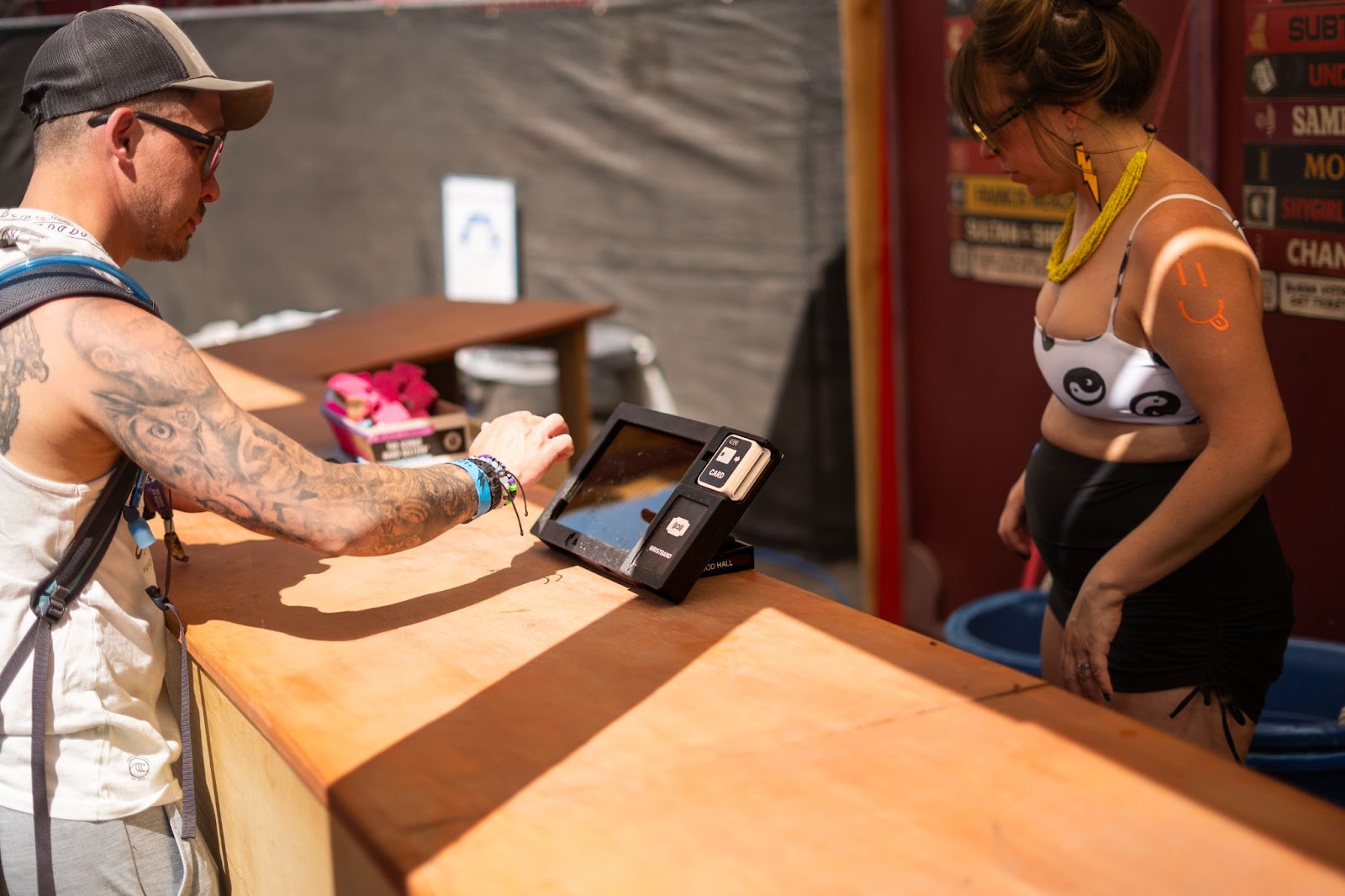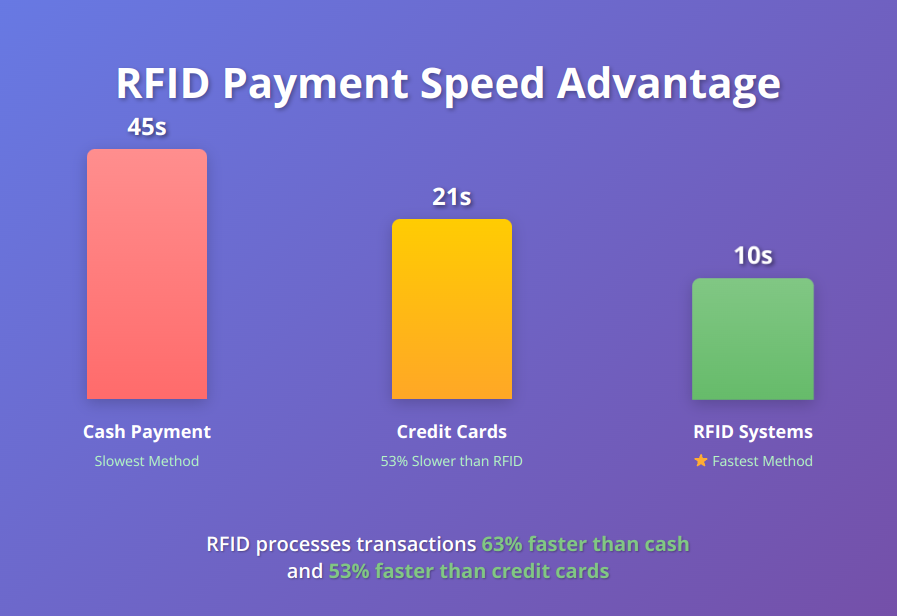Event RFID Payment: How It Works and Why It's Secure

Event RFID payment systems revolutionize cashless transactions through radio-frequency technology that processes payments in milliseconds.
- Advanced security features including encryption, tokenization, and unique transaction codes prevent fraud and unauthorized access
- Operational efficiency gains with transaction speeds up to 63% faster than cash and 53% faster than credit cards
- Revenue enhancement opportunities through increased spending (up to 30%), reduced cash handling costs, and valuable analytics data
- Comprehensive event management combining payments, access control, and real-time tracking in one solution
Event organizers implementing RFID payment solutions should prioritize security protocols while maximizing the technology's efficiency benefits.
Event RFID payment systems represent a transformative shift in how attendees interact with vendors, eliminating the friction of traditional payment methods while delivering unprecedented security and operational insights. These sophisticated systems combine radio-frequency identification technology with advanced encryption protocols to create seamless, secure transaction experiences that benefit both event organizers and attendees.
The global RFID market continues its explosive growth trajectory, with market analysts projecting the industry will reach $37.71 billion by 2032, exhibiting a compound annual growth rate of 11.9%. This expansion reflects the technology's proven ability to streamline operations across diverse sectors, with event management emerging as one of the most compelling applications.
How Event RFID Payment Technology Works
Event RFID payment operates through a sophisticated three-component ecosystem designed for speed, security, and reliability. Understanding this technical foundation reveals why major festivals and venues worldwide have adopted this technology as their primary payment infrastructure.

Core System Components
RFID tags form the foundation of the payment system, typically embedded within durable wristbands, cards, or badges distributed to attendees. These tags contain microchips and antennas that store encrypted payment credentials and unique identifiers. Unlike traditional magnetic stripe cards, RFID tags require no physical contact with payment terminals, enabling transactions through electromagnetic field activation.
RFID readers strategically positioned throughout event venues emit continuous radio waves at specific frequencies, typically 13.56 MHz for payment applications. When an RFID tag enters the electromagnetic field, usually within 2-4 inches of the reader, it harvests sufficient energy from the radio waves to power its integrated circuit and transmit stored data back to the reader.
Backend processing systems manage the complex data flows between readers and existing payment networks. These systems handle real-time transaction processing, account management, fraud detection, and integration with event management software, creating a unified platform for payments, access control, and analytics.
Transaction Process Flow
The payment process begins when attendees receive their RFID-enabled wristbands during registration or entry. Events link these wristbands to attendees' payment accounts through secure enrollment stations or through QR code located on the wristband itself, establishing the connection between the physical device and financial credentials.
During transactions, attendees simply tap their wristbands near vendor payment terminals. The RFID reader immediately activates the tag, retrieves encrypted payment data, and transmits this information to the backend system for processing. Within milliseconds, the system verifies account credentials, checks available funds, and either approves or declines the transaction.
This streamlined process eliminates the time-consuming steps associated with cash counting, card insertion, or PIN entry. Research indicates that RFID transactions process 53% faster than credit cards and 63% faster than cash transactions, dramatically reducing queue times and improving attendee satisfaction.
Advanced Security Features That Protect Every Transaction
Event RFID payment systems employ multiple layers of security that often exceed the protection offered by traditional payment methods. Understanding these security mechanisms addresses common concerns about contactless payment vulnerability while highlighting the technology's robust protection capabilities.

Encryption and Dynamic Authentication
Modern RFID payment systems implement advanced encryption standards including AES (Advanced Encryption Standard) that transform sensitive payment data into unreadable formats. This encryption occurs at multiple points throughout the transaction process, ensuring that even if communication signals were intercepted, the data would remain completely useless to unauthorized parties.
Dynamic authentication generates unique transaction codes for every payment, making it impossible for fraudsters to replay intercepted transaction data. Each RFID payment creates a one-time cryptographic signature that becomes invalid immediately after use, providing protection against sophisticated cloning attempts.
Tokenization Technology
Payment tokenization replaces sensitive account information with randomly generated tokens that have no mathematical relationship to the original data. When attendees make purchases, the system transmits these meaningless tokens rather than actual payment credentials, ensuring that merchant systems never access or store real financial information.
Even if tokens were somehow compromised, they cannot be reverse-engineered to reveal underlying account details or used for unauthorized transactions outside the specific event environment. This tokenization approach provides an additional security layer that protects both attendees and event organizers from potential data breaches.
Physical Security Measures
RFID wristbands incorporate unique identifiers that are virtually impossible to duplicate or transfer between devices. If attendees lose their wristbands, event staff can immediately deactivate the compromised device and issue a replacement without exposing underlying payment accounts to fraud risk.
The limited read range of event RFID systems, typically 2-4 inches, prevents unauthorized scanning from a distance. This proximity requirement, combined with encrypted communication protocols, makes "skimming" attacks practically impossible in real-world event environments.
Why RFID Cashless Payment Systems Boost Revenue and Efficiency
Event organizers implementing RFID payment solutions consistently report significant improvements in both operational efficiency and revenue generation. These benefits stem from the technology's ability to eliminate traditional payment bottlenecks while providing valuable insights into attendee behavior and preferences.
Transaction Speed and Volume Impact
The speed advantages of event RFID payment translate directly into increased sales opportunities. When vendors can process transactions in seconds rather than minutes, they serve substantially more customers during peak periods. This efficiency becomes particularly valuable at high-traffic events where queue length often determines purchase decisions.
Studies indicate that attendees using cashless payment systems spend up to 30% more than those using traditional payment methods, such as card, apple pay, and cash. This increase occurs because the frictionless payment experience encourages impulse purchases while eliminating the psychological barriers associated with physical cash transactions.

Operational Cost Reduction
RFID systems eliminate many of the hidden costs associated with cash handling, including security transportation, manual reconciliation, and theft prevention. Event organizers report significant reductions in payment processing overhead after implementing comprehensive cashless solutions.
The automated nature of RFID transactions also reduces the staffing requirements for payment processing, allowing event teams to reallocate personnel to customer service and experience enhancement activities that drive greater attendee satisfaction.
Real-Time Analytics and Insights
RFID payment systems generate rich data streams that provide unprecedented visibility into event operations. Organizers can monitor real-time sales patterns, identify popular vendors and products, and track attendee movement throughout venue spaces.
This information enables dynamic resource allocation during events, such as redirecting staff to high-demand areas or adjusting vendor inventory based on real-time consumption patterns. Post-event analysis reveals trends that inform future planning decisions and vendor management strategies.
Top 7 Security Features of Event RFID Payment Systems
Event RFID payment systems incorporate multiple security layers that work together to create comprehensive protection against fraud, theft, and unauthorized access. These features address both technological vulnerabilities and operational security concerns.
- Multi-Layer Encryption Protection Advanced cryptographic protocols encrypt data at rest, in transit, and during processing, ensuring that sensitive information remains protected throughout the entire transaction lifecycle.
- Dynamic Transaction Codes Each payment generates unique, one-time authentication codes that become invalid immediately after use, preventing replay attacks and transaction cloning attempts.
- Tokenization Shield Sensitive payment credentials are replaced with meaningless tokens that cannot be reverse-engineered or used outside the specific event environment.
- Instant Deactivation Capability Lost or stolen RFID devices can be immediately disabled through the management system, preventing unauthorized usage while maintaining account security.
- Limited Read Range Protection The 2-4 inch operational range prevents unauthorized scanning attempts while ensuring reliable performance during legitimate transactions.
- Tamper-Resistant Hardware RFID tags incorporate physical security features that make duplication or modification extremely difficult without specialized equipment.
- Real-Time Fraud Monitoring Backend systems continuously analyze transaction patterns to identify suspicious activity and automatically flag potentially fraudulent behavior for immediate investigation.
Real-World Applications Across Event Types
Event RFID payment systems demonstrate remarkable versatility across diverse entertainment and business environments. Understanding these applications helps organizers evaluate the technology's potential impact on their specific event types and operational requirements.
Music Festivals and Large-Scale Events
Major music festivals have pioneered RFID adoption, with events like Coachella and Tomorrowland reporting significant operational improvements. These implementations handle hundreds of thousands of attendees while maintaining security, efficiency, and comprehensive attendee experience management.
RFID wristbands serve multiple functions beyond payments, including access control for different venue areas, VIP section management, and integration with social media platforms for enhanced attendee engagement.
Corporate Events and Conferences
Business events leverage RFID technology for streamlined registration processes, secure access management, and efficient networking facilitation. Attendees can use their RFID devices for workshop registration, product demonstrations, and business card exchanges while maintaining professional security standards.
The technology's analytics capabilities provide event organizers with detailed insights into attendee engagement patterns, session popularity, and networking activity that inform future event planning decisions.
Sporting Venues and Stadiums
Professional sports facilities implement RFID systems to manage massive crowds while providing premium fan experiences. The technology handles concession purchases, merchandise transactions, and premium area access control through unified platforms that reduce operational complexity.
Real-time data analytics help venue operators optimize staffing, inventory management, and fan flow during high-attendance events while maintaining security and operational efficiency.
Comparing RFID with Other Event Payment Methods
Understanding how event RFID payment compares with alternative technologies helps organizers make informed decisions about their cashless payment strategies. Each approach offers distinct advantages and limitations depending on specific event requirements and attendee demographics.

RFID vs. NFC Mobile Payments
While both technologies operate on similar radio-frequency principles, RFID and NFC systems serve different operational needs. NFC requires smartphone compatibility and battery power, making it vulnerable to device failures during extended events.
RFID wristbands eliminate dependency on personal devices while providing superior durability for outdoor events, multi-day festivals, and environments where smartphones might be damaged or depleted.
Traditional Contactless Cards vs. Event RFID
Standard contactless payment cards offer convenience but lack the comprehensive event management capabilities of dedicated RFID systems. Event-specific RFID solutions integrate payments with access control, analytics, and attendee experience features that traditional payment cards cannot provide.
The closed-loop nature of event RFID systems also enables organizers to capture valuable transaction data that flows to banks when using standard payment networks, limiting insights and revenue optimization opportunities.
Cash and Traditional Card Comparison
Cash transactions create significant operational burdens including security risks, manual reconciliation requirements, and staffing overhead. Traditional card payments, while more secure than cash, introduce processing delays and equipment reliability concerns that can impact attendee satisfaction.
RFID systems eliminate these operational challenges while providing superior security, faster transaction processing, and comprehensive data insights that cash and traditional cards cannot deliver.
Implementation Best Practices for Event Organizers
Successful RFID payment implementation requires careful planning, comprehensive staff training, and attendee communication strategies that maximize adoption while ensuring smooth operations. These practices help organizers avoid common pitfalls while realizing the technology's full potential.
Pre-Event Planning and Setup
Event organizers should begin RFID planning during early event design phases, ensuring adequate reader coverage throughout vendor locations and high-traffic areas. Infrastructure requirements include reliable network connectivity, backup power systems, and integration with existing event management platforms.
Staff training should commence well before event dates, allowing team members to become proficient with RFID management systems, troubleshooting procedures, and attendee assistance protocols.
Attendee Communication and Adoption
Clear communication about RFID payment benefits helps attendees understand the technology while addressing potential security concerns. Pre-event messaging should explain enrollment processes, payment procedures, and security features that protect their financial information.
On-site demonstration stations and staff assistance during initial transactions help attendees become comfortable with the technology while reducing confusion and adoption barriers.
Security Protocol Implementation
Comprehensive security protocols should address both technological and operational aspects of RFID system management. These include regular system monitoring, incident response procedures, and coordination with financial institutions for fraud prevention.
Security best practices should encompass staff access controls, data handling procedures, and emergency protocols for system failures or security incidents.
The Future of Event Payment Technology
Event RFID payment systems continue evolving with emerging technologies that promise even greater capabilities and security features. Understanding these trends helps organizers prepare for future developments while maximizing current technology investments.
Artificial intelligence integration enables more sophisticated fraud detection, predictive analytics for inventory management, and personalized attendee experience recommendations based on historical behavior patterns.
Blockchain technology offers potential enhancements for transaction verification, cross-event loyalty programs, and enhanced security through distributed ledger systems that provide immutable transaction records.
Integration with Internet of Things (IoT) devices creates opportunities for comprehensive venue management that extends beyond payments to include environmental monitoring, crowd density management, and predictive maintenance systems.
As payment technology evolution continues accelerating, event organizers who implement robust RFID foundations today position themselves to adopt future innovations seamlessly while maintaining operational continuity and attendee satisfaction.
FAQ
How secure are RFID wristbands compared to traditional payment cards? RFID wristbands employ multiple security layers including encryption, tokenization, and dynamic authentication that often exceed traditional card security. Each transaction generates unique codes that become useless if intercepted, while instant deactivation capabilities protect against lost device fraud.
Can RFID payment systems work without internet connectivity? Yes, many RFID systems can operate in offline mode, storing transaction data locally until connectivity is restored. This capability makes RFID particularly valuable for outdoor events or locations with unreliable network access.
What happens if attendees lose their RFID wristbands during an event? Lost wristbands can be immediately deactivated through the management system, preventing unauthorized use. Event staff can quickly issue replacement devices without exposing underlying payment accounts to fraud risk.
How much faster are RFID transactions compared to cash or card payments? RFID transactions process approximately 53% faster than credit cards and 63% faster than cash transactions, significantly reducing queue times and improving operational efficiency during peak periods.
Do RFID payment systems increase attendee spending at events? Research consistently shows that attendees using cashless payment systems spend 22-30% more than those using traditional payment methods, driven by the frictionless transaction experience and elimination of cash spending limits.
Ready to Transform Your Event Payment Experience?
Event RFID payment systems represent a fundamental advancement in how events manage transactions, security, and attendee experiences. The technology's combination of speed, security, and comprehensive functionality makes it an essential tool for modern event operations seeking to maximize efficiency while providing superior attendee satisfaction.
The compelling financial benefits, including increased spending, reduced operational costs, and valuable analytics insights, create strong business cases for RFID adoption across diverse event types. Combined with robust security features that often exceed traditional payment methods, these systems address both operational needs and risk management requirements.
For event organizers ready to transform their payment infrastructure and attendee experiences, Billfold's advanced RFID solutions provide the technology, support, and expertise needed to implement successful cashless payment systems that drive both operational excellence and revenue growth.

